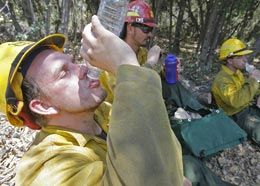 AP Photo/Jae C. Hong Firefighters rehydrate after tackling a fire in Calif. in July last year. |
We all know what it takes to put out a structure fire — it isn’t just the equipment, the staffing or tactics, but a combination of all three. It never hurts to have other factors such as weather conditions, building construction, adequate water supply and quick response times working in our favor, too.
But in other ways, fire departments do tend to operate within their own culture and philosophy, even when following NFPA guidelines along with state and federal requirements.
This might explain why firefighters like to “buff” other departments. We tend to read the trade journals and magazines looking for techniques that would enhance our operation; we open up the compartment doors of other rigs to see how they are set up; and our family vacation trips include a mandatory visit to the neighborhood firehouse.
Get two or more firefighters together and you can assume they will soon be talking about firefighting. Be honest and estimate how many blue T-shirts you own without your own fire department name on it. This is a good thing. We are willing to share our techniques with others and show off what we are proud of and we train like our lives depend on it, which of course they do.
So how does this fit in with a column on fire rehab? I wanted to know how other departments set up their rehab sectors. And, with the advent of computers, all we have to do is a Google search to see what comes up.
Personalized systems
For this month’s article, I have brought together a list of department rehab units. I enjoyed looking at these various websites — what an impressive array of equipment they highlight. But what works in one department isn’t always the case in another, which is why you can personalize your system to what works best for you.
I am relatively new at writing about what I have experienced in my 25 years of firefighting and athletic training, so checking out these sites is a plus. If your unit doesn’t appear on the list, it would be great to hear from you and then we can list your department. You should be proud of the work and efforts your group contributes to the community.
Please share any photos or stories as well; this column has a forum section as well as the new member comments function, which comes at the end of this and all articles on FireRescue1. Let’s continue to try to generate some dialogue and discussion — the establishment of a solid rehab sector probably won’t make the headlines in many other places, so let’s use the chance we have here.
It’s always vital to remember that failing to adequately rest, hydrate or cool off an exhausted firefighter could have a disastrous ending. I believe the real challenge here is to convince departments presently not using proper rehab of its value.
With some effort and planning, perhaps you can find members of your community who would be willing to assist your department in this phase of operation. Your department could even find a reserve corps of volunteers willing to help out.
There’s no harm in giving this a try; we’re not talking about someone losing their job and a reduction in manpower here. We are merely attempting to supplement our firefighting forces with other trained, motivated personnel. I congratulate those departments that have already shown initiative is harnessing the resources that are out there — now tell us about them, so we can maybe do the same. Hopefully, I will be able to add many more department websites in my next column. Until then, be proud and keep the minitor cranked up!
- You can email Perry Denehy at denehyp@sycamoreschools.org
Selection of department rehab sectors
City of Fountain, Colorado Fire Department Auxiliary
www.fountaincolorado.org/department/division.asp?fDD=9-168
Box 4 of Dallas Texas
www.box4.org
Texas Volunteer Mobile Emergency Response Unit
www.rehabsector.org/
Special Signal Fire Association Rhode Island
www.ifba.org/clubs/specialsignal/SpecialSignalAssn.htm
Atlas Fire Company
www.atlasfireco.com/history.html
Union Fire Company No. 1 Manchester, Pa.
www.unionfire23.com/equipment.htm
The Greater Toronto Canada Multiple Alarm Association
www.gtmaa.com/home.htm
Box 55 Nashville, Tennessee Fire Buffs
www.box55.org/index.html
Fremont California Rehabilitation Unit
www.ci.fremont.ca.us/Fire/SpecialPrograms/RehabilitationUnit.htm
Racine Fire Bells, Inc Racine, Wisconsin
www.racinefirebells.org/rfbcpg8.html
Pinetop Arizona Fire Department Rehab
www.pinetopfire.com/rehab.html
Deer Park Fire Company NJ Rehab Unit
www.deerparkfire.com/apparatus.php
Moreno Valley Volunteer Fire Department Support Unit
www.morenovalleyfire.com/?page_id=4
Sacramento CA Volunteer Fire Reserves
www.firereserves.org
Friendship NJ Fire Association
www.friendshipfire.org/index/html
Franklin Twp. Indiana Tactical Support Unit
www.franklintwpfire.org/page5_2.php
Teanuck NJ Box 54 Club
http://box54.org/firelink.html
NAVAC Fire Rehab Team
http://navac.org/rehabteam.htm
Passaic Countywide Fire Rehab and Canteen
www.volunteersolutions.org/uwpassaic/org/2485080.html
Pike’s Peak Region Rehab Services
http://pikespeakfire.org?RehabServices.htm
Grapevine Texas Citizen’s Fire Academy Alumni
www.gcfaa.org/index.html
Loveland-Symmes FD Ohio Emergency Services Unit
www.lsfd.org
Southern Essex County Massachusetts Fire Rehab
www.rehabfire.org/
| Discuss this article at FireRescue1 Forums |











